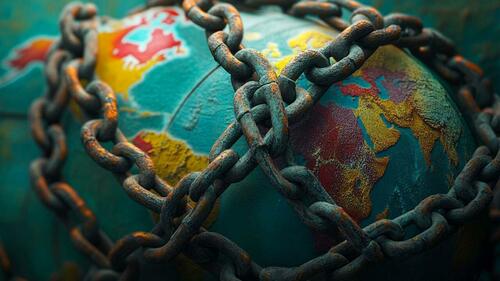First there was the first Trump trade war, which appeared to end before it began.
Now, a dizzying Round Two has begun of the Trump tariff saga, and it isn’t clear what concessions will be made.
But there is a common denominator: things change quickly under a Trump administration, with a rapid-fire news cycle and manic-depressive markets struggling to keep up with the latest announcement.
Whether it’s a statement about tariffs, a new Truth Social post about cuts, or a dramatic televised meeting about finding peace in Ukraine and closing a minerals deal, the market is constantly trying to figure out if the most recent development will make for a Trump pump or a drop. The rapid, unpredictable shifts leave markets reeling, from Trump Trade to selloff and back again.
Trump’s February announcement of 25% tariffs on Canada and Mexico and a doubled 20% levy on China: the S&P 500 plummeted 1.76%, the Dow shed nearly 1.5%, and the Nasdaq cratered 2.6% in a single session. Bond yields tumbled as investors fled to safety in fear of higher prices, inflation, and disrupted supply chains. Within days, Trump’s suggestion of a potential compromise tied to immigration or fentanyl controls sent futures ticking upward again. However, markets were clearly spooked in February when Trump’s tariff announcements began in earnest.
More recently, a wave of news just came out about retailers telling consumers to expect higher prices on all kinds of goods, as major brands comment that everything from food to furnaces and ACs will cost more as they pass their higher prices onto American families. Tariff target countries Canada, Mexico, and China have announced new retaliatory measures.
Canada is threatening levies on goods ranging from tobacco to firearms. Mexico, hit with the same rate, is eyeing tariffs on $15 billion in US exports like pork and semiconductors, while China has escalated with 15% counter-tariffs on US coal and gas. These tit-for-tat measures echo the 2018-2019 trade war, when China’s retaliation slashed U.S. farm exports, hammering rural economies. Tariffs and counter-tariffs are a tax on prosperity, not a solution to ballooning deficits and other economic woes.
Now, days after the dramatic Zelenskyy meeting, the Ukrainian leader is signaling he is ready to talk about the deal wherein the US would be repaid for war aid in the form of access to Ukraine’s mineral resources like lithium and rare earths that are critical for tech and defense industries.
Meanwhile, Trump is hinting at a compromise with his latest wave of tariffs against Canada, Mexico, and China, even if the tariffs won’t be completely reversed. Trump’s style is to assert himself as the Dealmaker in Chief, finding sources of economic leverage to wage a form of transactional diplomacy where the outcome of every meeting is tied, ultimately, to some new or modified economic arrangement. It’s a distinctly Trumpian style of governance.
But markets are so focused on the economic effects of the tariffs that a deeper issue is hardly being addressed: the executive branch of a country shouldn’t be allowed to unilaterally decide on what tariffs should or shouldn’t exist. Tariffs should be enacted through acts of Congress, not executive fiat.
Historically, tariffs were Congress’s domain — like the Smoot-Hawley Tariff Act of 1930, which deepened the Great Depression by slashing global trade 66% in three years. Today, Trump’s use of the International Emergency Economic Powers Act (IEEPA) bypasses legislative oversight. As is often the case, an “emergency” is being used to justify excessive executive reach.
Just like economic sanctions, tariffs are a form of war, and countries that trade with each other aren’t generally fighting with each other. For example, if the US is trading with Russia and trading with Ukraine at the same time, it’s unlikely that the US will also be at war with either of those countries. But just as importantly, it makes it much less likely that those two countries will be at war with each other, either. Escalating tariffs on China could push Beijing and Moscow closer as Trump tries to close his mineral deal in Ukraine and end the war led by Putin and Zelenskyy.
The tariff frenzy, like all state intervention, distorts markets and misallocates resources. True price discovery becomes impossible. Free trade fosters efficiency, peace, and lower prices by encouraging cooperation and aligning production, price, and demand. Tariffs increase prices as consumers bear the brunt, and spark conflict as targeted countries retaliate with their own levies. As Peter Schiff recently said on Palisades Gold Radio about the state micromanaging the economy:
“That’s assuming that you want to entrust the economy to a handful of bureaucrats who think they know more than the market. I would rather have sound money. I don’t want central government planning…they don’t solve problems, they create bigger problems.”
Gold, the ultimate barometer of economic unease, stands to benefit. When Smoot-Hawley triggered inflation and uncertainty, gold demand surged as a hedge. Adjusted for inflation, its price climbed dramatically from 1930 to 1934 after FDR’s revaluation. Today, with gold hovering near $2,900 per ounce, a further rally could be incoming as fiat currencies falter under inflationary pressure and trade war instability.
As uncertainty reigns, gold’s luster grows as a tangible escape from a world where trade wars threaten prosperity, prices, and peace. Whether Trump’s threats lead to fast concessions or a more drawn-out economic conflict, gold will shine as a safe haven from market uncertainty over which is the correct answer.
Loading...
